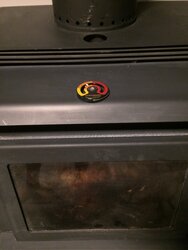The answer to your question of "burn time" has many facets and is based upon:
- Desired inside temperature
- House size
- Level of insulation in the house
- Outside temperature
- Woodstove efficiency percentage rating (equates to the amount of heat not going "up the chimney"
- BTU's per hour
- Combustion chamber size (amount of wood the stove will hold)
- Wood type being burned
- Wood moisture content
- Draft
With that being said, I'm sure there is a mathematical formula to solve this problem but it will take a greater mathematician than I to develop it.
Here are my answers to the above points as it relates to my house and the Progress Hybrid.
- Desired inside temperature: 70 degrees
- House size: 2,400 sq. ft.
- Level of insulation: Normal (not really tight)
- Outside temperature: 30 degrees Fahrenheit
- Woodstove efficiency rating: 81%
- BTU's per hour: 73,171
- Combustion chamber size: 2.8 cubit feet
- Wood type burned: Primarily red oak
- Wood moisture content: Under 20%
- Draft: Normal
With the above considerations, I can get between 10 to 12 hours of "burn time" maintaining a stove temp above 350 degrees and can maintain an average temperature of 70 degrees inside the house. Also, I consider "burn time" from the start of a fire to a minimal level of coals in the stove in which I can restart the fire.
Definitely not "scientific" enough to really answer your question but that's my "two-cents" worth....




 . My stove is in my man cave downstairs and i Dont let it go above 450-500 too long cause the room will start going above 83 when im in it. Just was watching the show on netflix THE OA pretty weird but even better when your near wood heat and relaxing.
. My stove is in my man cave downstairs and i Dont let it go above 450-500 too long cause the room will start going above 83 when im in it. Just was watching the show on netflix THE OA pretty weird but even better when your near wood heat and relaxing. ). It's nice most of the year but when it gets cold out you know it and I have to push the stove to keep up with the heat loss. This is with new double pane windows all around. Unfortunately even good windows don't provide much R value.
). It's nice most of the year but when it gets cold out you know it and I have to push the stove to keep up with the heat loss. This is with new double pane windows all around. Unfortunately even good windows don't provide much R value.